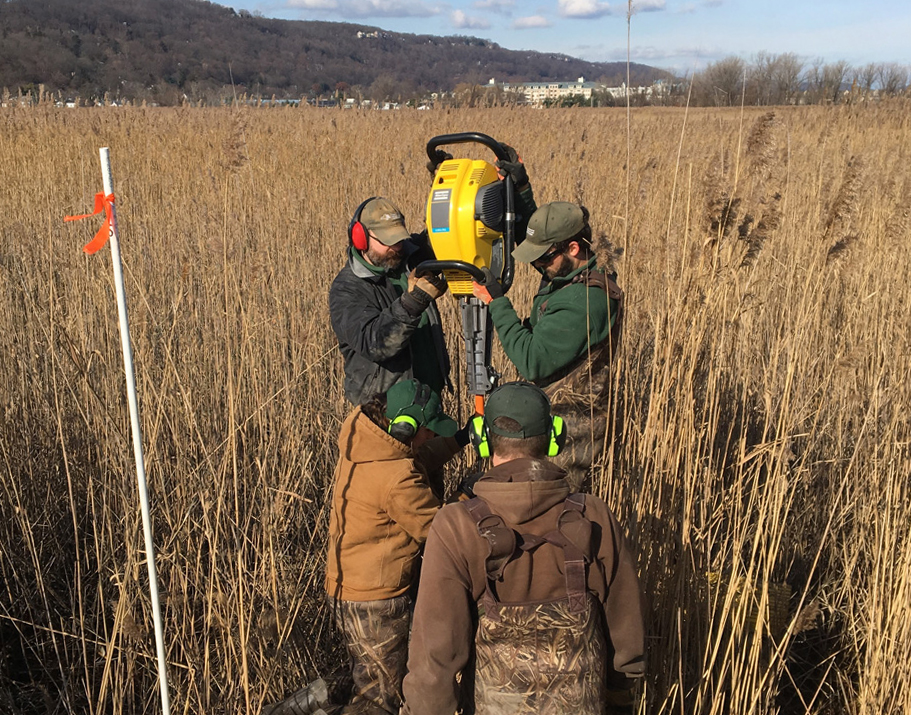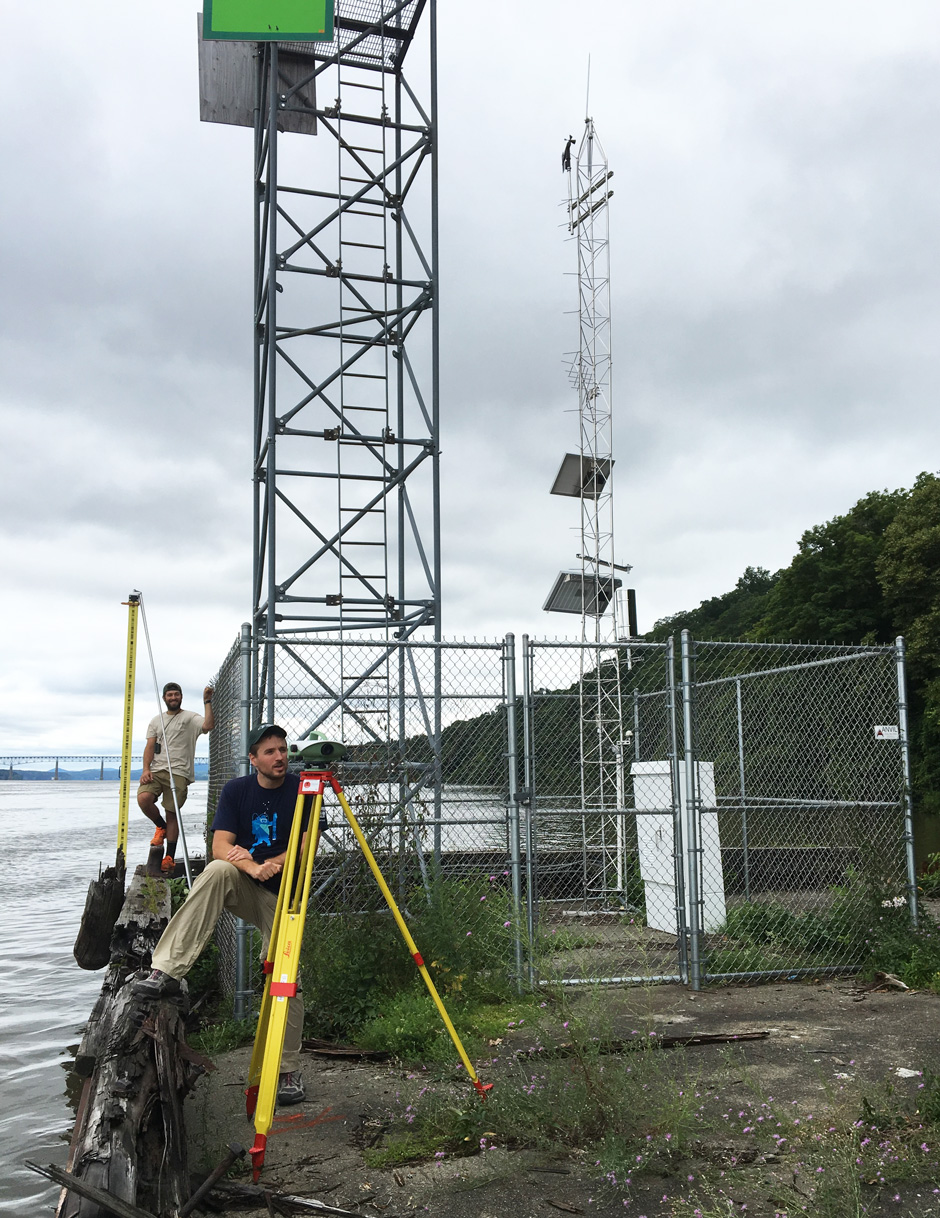Health, Resilience and Stewardship in the Hudson River: Responding to Climate Emergencies
 Researchers installing a Surface elevation table (SET) at Piermont Marsh, Rockland County. HRNERR uses this to measure sediment accrual in the Marsh (Credit: HRNERR)
Researchers installing a Surface elevation table (SET) at Piermont Marsh, Rockland County. HRNERR uses this to measure sediment accrual in the Marsh (Credit: HRNERR)The Hudson River National Estuarine Research Reserve (HRNERR) is dedicated to improving the health and resilience of the Hudson River Estuary through integrated education, training, restoration, monitoring, and research programs that foster stewardship of the world’s resources. HRNERR is one of 30 research reserves across the National Estuarine Research Reserve System, in partnership with the National Oceanic Atmospheric Administration (NOAA). Through the research reserve’s System-Wide Monitoring Program (SWMP) and local actions like the Hudson River Estuary Action Agenda, the HRNERR is committed to putting federal funding, science and tools toward benefitting Hudson River communities and natural resources.
Long-term monitoring projects like the HRNERR’s water quality monitoring program are included in the national SWMP. Each state research reserve works to contribute to the millions of water quality data points collected annually. This data is public to researchers, land managers and community members who are invested in their local waters. HRNERR collects site-specific water quality and weather data every 15 minutes at several sites along the Hudson, which allows researchers to track the ecological functions and changes that occur within the region.
Local Concerns
Climate change, in particular, has led to increasing rates of change across the globe, including local shifts observed by HRNERR. “We have experienced droughts, fires, hurricanes, and major anthropogenic impacts due to centuries of industrial activity and population growth,” says Christopher Mitchell, a Research Assistant with the Research Reserve. Having been devastated by Hurricane Sandy only a decade ago, environmental monitoring is more important than ever. Mitchell adds, “You don’t have to go back very far in time to see how big of an impact flooding from Hurricane Sandy had on the northeast. Our instruments and monitoring were able to provide a great snapshot of how the Hudson River adjusted with such a large input of freshwater and sediment.”
The Hudson River Environmental conditions Observing system (HRECOS) is run by a team of researchers dedicated to benefiting the region and its inhabitants. “I work with a great team who allow us to collect over 2 million data points annually,” says Mitchell. Mitchell and his team work to provide and maintain a consistent baseline of environmental monitoring. He explains, “Long-term trends require lengthy datasets, and extreme weather, tidal, or seismic events are unpredictable at best. Continuous monitoring allows us to catch almost any event, both long- and short-term, some which would have otherwise gone unnoticed.”
Dramatic shifts in ecology, weather patterns and water quality can have negative impacts on plant, animal, and human life near the Hudson River. “The Hudson River Valley is one of the most densely populated regions in the country, and events in the river can impact communities, resources, and ecosystems along its shorelines.” In hopes of protecting coastal environments, HRNERR began the process of creating the only permanent NOAA-sanctioned tidal monitoring station in the Hudson River, north of New York Harbor. Adoption of the station, located 100 miles north of Manhattan, was finalized in 2017, and the station was accepted into NOAA’s National Water Level Observation Network (NWLON).

Researchers installing the Tide Station at Turkey Point, Ulster County (Credit: HRNERR)
Monitoring Climate Change in the Hudson River
Including the HRNERR tide station in NOAA’s NWLON allows for more accurate tidal predictions, flood event observations, and flood predictions throughout the Hudson River. “These data are critical for research, recreation, and shipping,” explains Mitchell. The Hudson River is a major water highway for vessels traveling from the Midwest through the Great Lakes region.
Monitoring multiple climate parameters continuously and in a large area is no easy task. The HRNERR team relies on YSI multiparameter sondes, Campbell Scientific data loggers and a SEAL AutoAnlayzer. More than anything, though, the team depends on each other. “It goes without saying that the most important piece of equipment we have is our staff. Trying to sample dynamic, ever-changing environments with static instrumentation takes a great deal of ingenuity, determination, and field savvy that not a single piece of equipment can replace,” says Mitchell.
The earth’s systems are quite complicated, and monitoring climate change occurs over long periods of time that may not always be indicated by extreme weather events. While Hurricane Sandy and other disasters may alert to more immediate concerns, they are the result of building ecological shifts. “Everything is interconnected; aquatic, marine, terrestrial, and atmospheric environments all play integral roles in the system as a whole,” explains Mitchell.
These changes will continue to impact the world, and monitoring is essential to assessing future impacts. By recognizing that sea level rise will occur due to thermal expansion and the melting of land-based ice, coastal regions may be better prepared. A significant part of the Hudson River Estuary Action Agenda is creating a resilient watershed area with climate-adaptive and resilient communities, something that can only be done through data-informed management strategies. Learning how climate change will impact the future is a key part of preventing devastating impacts.
Conclusion
Considering the nature of the climate, work for researchers like Mitchell is ever-changing. However, HRNERR and their team of researchers are not deterred, “The best thing about working in this position is that every day brings an entirely new adventure or perspective. No two days are ever the same, even if sometimes it would be easier if they were,” states Mitchell. As much as the situation may seem hopeless, Mitchell and many other conservationists feel differently, “I like to think that we all have our part in protecting the health of the planet,” says Mitchell.
Monitoring empowers future actions—observing an effective management strategy, in comparison to another, can help prepare communities for disasters and improve the environment. Regardless, monitoring is vital in all environmental work. Mitchell explains, “Even though monitoring doesn’t always get recognized as a glorious component our data is available to provide context for questions people may have about the river.”




0 comments